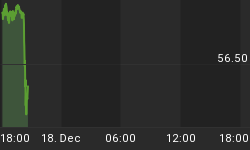Bloomberg's latest report on Chinese gold imports is a great illustration of a journalist's power to shape a message by highlighting certain data points and downplaying others. Here's the article:
China Gold Imports From Hong Kong Fall on Premium, Slow Demand
Gold shipments to China from Hong Kong fell for a second month after the premium to take immediate delivery declined, indicating waning physical demand in the nation poised to become the largest consumer.
Net imports, after deducting flows from China into Hong Kong, were 109.4 metric tons in September, from 110.2 tons a month earlier, according to Bloomberg calculations based on data e-mailed from the Hong Kong Census and Statistics Department. Still, the amount has more than doubled to 826 tons in the first nine months of the year, the data show.
Gold prices dropped in September for the first loss in three months amid speculation at the time that the U.S. Federal Reserve would slow its $85 billion in monthly bond purchases. The average premium that Chinese buyers paid to take gold for immediate delivery in Shanghai fell to $8.97 in September, compared with $13.57 a month earlier.
"Demand eased a bit in September as investment in China remained sensitive to the gold price outlook," said Wang Weimin, an analyst at Dalian Fortune Futures Co., before the announcement. "A lower premium was a good indicator that Chinese investment demand slowed after more sell-offs following the gold rout in April and in June."
Gold for immediate delivery in London traded at $1,323.91 an ounce at 10:18 a.m. Beijing time. Bullion, which dropped as low as $1,180.50 an ounce on June 28, has declined 21 percent this year as investors reduced holdings in exchange-traded products on prospects for a global economic recovery.
Overtaking India
China's total gold consumption this year may jump 29 percent to reach 1,000 tons, overtaking India to become the world's largest user, according to the World Gold Council. China and India combined account for more than half of the world's demand, according to the WGC.
Mainland buyers purchased 116.3 tons in September, including scrap, compared with 131.4 tons in August, data from the Hong Kong government showed.
China's purchases in September were 67 percent higher than the 69.7 tons a year earlier, according to the Hong Kong data. Mainland China doesn't publish such data.
Exports to Hong Kong from China were 6.9 tons in September, according to the e-mail today, compared with 21.3 tons in August and 28.2 tons in September 2012.
Bullion of 99.99 percent purity on the Shanghai Gold Exchange fell for the first time in three months in September, dropping 4.4 percent.
Now, despite including a lot of really positive stats, the article's clear message is that Chinese gold demand is headed down. But the same data could have driven a completely different slant. The title of the gold-bug version might be "Chinese Gold Demand Remains Robust," and the introductory sentence "Chinese September gold imports exceeded 100 tons for the seventh straight month." The article would then go on to highlight rather than mention in passing the massive year-over-year growth in demand.
And the gold-bug's version would have included an explanation of why readers should care about Chinese gold demand in the first place. Specifically, how its imports compare to what the world's gold mines are producing (nearly half) and how between them China, India and Russia are vacuuming up all the gold flowing out of mines this year, leaving the rest of the world's gold buyers to be satisfied from ... where? That question would dominate the last third of the article.
And last but not least there would be a catchy visual comparing 2013 monthly gold imports to 2012's record levels. Looking at this chart, the last word that comes to mind is "waning."

















